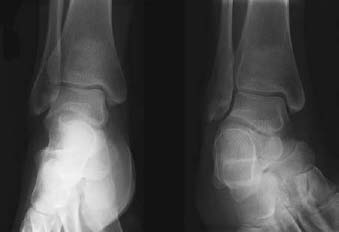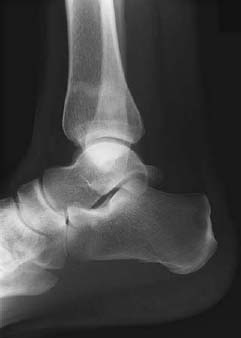CASE 89 Hema N. Choudur, Anthony G. Ryan, and Peter L. Munk A young marathon runner presented with severe pain in the right shin. There was no history of direct or indirect trauma. Figure 89A Figure 89B Anteroposterior and lateral views of the right tibia (Figs. 89A, 89B) reveal a transverse sclerotic band in the distal tibia with no evidence of adjacent periosteal reaction or overlying soft-tissue swelling. Stress fracture. Stress or fatigue fractures result from excessive bone strain that causes microdamage to the bone, coupled with an inability to keep up with appropriate repair of the bone. They result from high-impact repetitive stress. The main cause of stress fractures is abnormal stress on a normal bone. This is often seen in athletes and military recruits who have suddenly started high-impact activity. Tennis, basketball, longdistance running, and gymnastics are activities in which the foot is constantly hit against a hard surface, resulting in stress fractures. Stress fractures are more common in females than males and are related to the triad of improper food habits with low calcium, amenorrhea, and osteoporosis. A sudden increase in the number of hours of activity, harder and flatter surfaces, and old and improper shoes are aggravating causes of stress fractures. Stress fractures of the upper extremity, which are less common than lower extremity fractures, may occur in sports involving repetitive use of the arms, such as baseball and tennis. Stress fractures of the ribs occur in sports such as rowing. Shin splints are vertically oriented stress fractures seen along the posteromedial tibial cortex, thought to be secondary to strain at the insertion of the soleus muscle on the underlying bone. Tibial fractures are the most common lower extremity stress fractures and account for about one half of all such fractures in children and adults. In children, tibial stress fractures usually occur anteriorly in the proximal one third of the bone, whereas in adults, these fractures are more prevalent at the junction of the middle and distal one thirds. Anterior stress fractures of the tibia have a higher incidence of nonunion than anteromedial fractures. Metatarsal fractures, accounting for approximately 25% of stress fractures, are most common in the distal second and third metatarsals and are least common in the fifth metatarsal. The former are called march fractures, as they are frequently seen in military recruits. Fifth metatarsal stress fractures must be distinguished from Jones fractures or avulsion fractures. Stress fractures of the calcaneum (Fig. 89C) and navicular are oriented in the sagittal plane.
Stress Fracture
Clinical Presentation


Radiologic Findings
Diagnosis
Differential Diagnosis
Discussion
Background
Etiology
Stay updated, free articles. Join our Telegram channel

Full access? Get Clinical Tree


